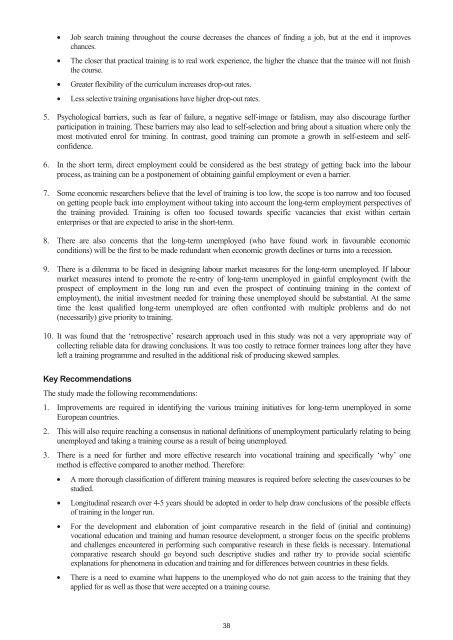briefing papers for policy makers
briefing papers for policy makers
briefing papers for policy makers
You also want an ePaper? Increase the reach of your titles
YUMPU automatically turns print PDFs into web optimized ePapers that Google loves.
• Job search training throughout the course decreases the chances of finding a job, but at the end it improves<br />
chances.<br />
• The closer that practical training is to real work experience, the higher the chance that the trainee will not finish<br />
the course.<br />
• Greater flexibility of the curriculum increases drop-out rates.<br />
• Less selective training organisations have higher drop-out rates.<br />
5. Psychological barriers, such as fear of failure, a negative self-image or fatalism, may also discourage further<br />
participation in training. These barriers may also lead to self-selection and bring about a situation where only the<br />
most motivated enrol <strong>for</strong> training. In contrast, good training can promote a growth in self-esteem and selfconfidence.<br />
6. In the short term, direct employment could be considered as the best strategy of getting back into the labour<br />
process, as training can be a postponement of obtaining gainful employment or even a barrier.<br />
7. Some economic researchers believe that the level of training is too low, the scope is too narrow and too focused<br />
on getting people back into employment without taking into account the long-term employment perspectives of<br />
the training provided. Training is often too focused towards specific vacancies that exist within certain<br />
enterprises or that are expected to arise in the short-term.<br />
8. There are also concerns that the long-term unemployed (who have found work in favourable economic<br />
conditions) will be the first to be made redundant when economic growth declines or turns into a recession.<br />
9. There is a dilemma to be faced in designing labour market measures <strong>for</strong> the long-term unemployed. If labour<br />
market measures intend to promote the re-entry of long-term unemployed in gainful employment (with the<br />
prospect of employment in the long run and even the prospect of continuing training in the context of<br />
employment), the initial investment needed <strong>for</strong> training these unemployed should be substantial. At the same<br />
time the least qualified long-term unemployed are often confronted with multiple problems and do not<br />
(necessarily) give priority to training.<br />
10. It was found that the ‘retrospective’ research approach used in this study was not a very appropriate way of<br />
collecting reliable data <strong>for</strong> drawing conclusions. It was too costly to retrace <strong>for</strong>mer trainees long after they have<br />
left a training programme and resulted in the additional risk of producing skewed samples.<br />
Key Recommendations<br />
The study made the following recommendations:<br />
1. Improvements are required in identifying the various training initiatives <strong>for</strong> long-term unemployed in some<br />
European countries.<br />
2. This will also require reaching a consensus in national definitions of unemployment particularly relating to being<br />
unemployed and taking a training course as a result of being unemployed.<br />
3. There is a need <strong>for</strong> further and more effective research into vocational training and specifically ‘why’ one<br />
method is effective compared to another method. There<strong>for</strong>e:<br />
• A more thorough classification of different training measures is required be<strong>for</strong>e selecting the cases/courses to be<br />
studied.<br />
• Longitudinal research over 4-5 years should be adopted in order to help draw conclusions of the possible effects<br />
of training in the longer run.<br />
• For the development and elaboration of joint comparative research in the field of (initial and continuing)<br />
vocational education and training and human resource development, a stronger focus on the specific problems<br />
and challenges encountered in per<strong>for</strong>ming such comparative research in these fields is necessary. International<br />
comparative research should go beyond such descriptive studies and rather try to provide social scientific<br />
explanations <strong>for</strong> phenomena in education and training and <strong>for</strong> differences between countries in these fields.<br />
• There is a need to examine what happens to the unemployed who do not gain access to the training that they<br />
applied <strong>for</strong> as well as those that were accepted on a training course.<br />
38


